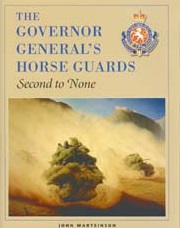 This information has been archived for reference or research purposes.
This information has been archived for reference or research purposes.
Archived Content
Information identified as archived on the Web is for reference, research or recordkeeping purposes. It has not been altered or updated after the date of archiving. Web pages that are archived on the Web are not subject to the Government of Canada Web Standards. As per the Communications Policy of the Government of Canada, you can request alternate formats on the "Contact Us" page.
BOOK REVIEWS
THE GOVERNOR GENERAL’S HORSE GUARDS: SECOND TO NONE
by John Marteinson with Scott Duncan
Toronto: Robin Brass Studio, 320 pages, $69.95
Reviewed by Donald E. Graves
For more information on accessing this file, please visit our help page.

The Governor General’s Horse Guards has one of the longest and most distinguished lineages in the Canadian Forces. The regiment traces its origins to a troop of cavalry raised in York (as Toronto was then called) in 1810, and it has participated, either as a unit or by detachment, in almost every military operation waged by Canadians since that time. This being the case, it is a mystery why this fine old regiment should have waited half a century to publish an updated history – its last having appeared in 1953.
The long wait, however, has certainly been worthwhile, for The Governor General’s Horse Guards: Second to None, the Horse Guards’ new history, is a splendid volume. In six lengthy chapters, John Marteinson skilfully interweaves historical record and personal account to tell the story of Canada’s senior Militia regiment from its beginnings to the present day. The author’s well-written text is amplified and enhanced by the book’s numerous illustrations (many of which are in colour) – for this is a pictorial history which include paintings, sketches, maps, orders of battle, excellent and accurate scale drawings of vehicles, organizational charts, cartoons and many superb photographs. The design and production values are up to the standard of other regimental/corps histories from Robin Brass Studio – without a doubt Canada’s foremost military publisher – and the result is a treat for the eye that is well worth the price.
The two chapters devoted to the Horse Guards’ participation in the Second World War are the centrepiece of the book. The unit’s wartime history is interesting because it was one of only two armoured reconnaissance regiments in the Canadian Army, the other being the South Alberta Regiment of 4th Canadian Armoured Division. The armoured reconnaissance regiment was a somewhat esoteric entity that originated in the reorganization of Commonwealth armoured divisions in late 1942. Loosely (and incorrectly) based on what the British War Office construed to be the function of the aufklärungsbataillon in the German panzer division, the armoured reconnaissance regiment’s job was to provide “close reconnaissance” for the divisional commander and to be prepared, if necessary, to fight for information.
In fact, nobody really knew what to do with this new entity as there was no role for it in the prevalent tactical doctrine and, in any case, its tasks in action were largely taken over by the corps reconnaissance units. This uncertainty is reflected by the fact that the organization of armoured reconnaissance regiments (which was based on a mix of tanks and light armoured vehicles) changed approximately every four months between January 1943 and January 1944. In February 1944, Montgomery ended the confusion – in 21st Army Group at least – by ordering that all armoured reconnaissance regiments under his command were to be reorganized as armoured regiments, although they would keep their distinctive titles. For this reason, the South Alberta Regiment fought primarily as the armour component of 10 Canadian Infantry Brigade in 1944–1945.
The Horse Guards, part of 5th Canadian Armoured Division, however, actually fought in the Italian Campaign as an armoured reconnaissance unit in the important Liri Valley and Gothic Line battles, but as the author makes clear, their operational experience was somewhat mixed. From the late summer of 1944 until it left Italy in early 1945, the unit carried out a great variety of miscellaneous roles, including acting as infantry on occasion, and performed them very well. When the regiment was transferred to Holland in 1945, they were reorganized as an armoured regiment and, in a similar fashion to the South Albertas, their primary function became to provide armour support for 11 Brigade.
The chapter devoted to the Horse Guards’ post-war history traces the almost continuous changes in organization, equipment and role suffered by all Canadian armoured units as policy changed – almost on a yearly basis. Marteinson, who is also the co-author of the recent history of the Royal Canadian Armoured Corps, is well equipped to deal with what could be a most confusing period and stresses the main points without becoming mired in insignificant details. It is interesting to note (although not comforting to know) that Canadian armoured policy has been more or less in a state of flux since 1936, although recent events in Iraq would seem to demonstrate beyond doubt that armour does still have an important role to play in the modern battlefield.
Throughout all this – and indeed since 1810 – The Governor General’s Horse Guards have, in the words of their Honorary Colonel, exhibited a tradition of “doing the best they can with what little is available” and, in this respect, their story is very similar to that of most Canadian regiments, in war and in peace. In terms of producing a pictorial record of their long, distinguished and interesting history, however, the Horse Guards have entirely lived up to their motto – “Second to None” – and the result is a excellent book that will appeal to a wide variety of readers.
Donald E. Graves is a heritage consultant who lives near Ottawa and the author of several books on military history including the well-received South Albertas: A Canadian Regiment at War.






